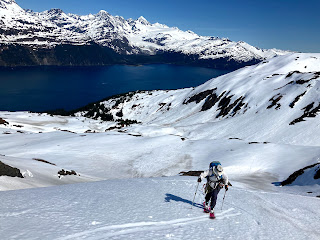Sound Skiing Sans Boat
Backcountry skiing above Prince William Sound is so magical it feels like an activity undertaken by your alternate self, as if you were a person existing in a parallel universe of simultaneously endless snow, sun, and bountiful marine life plying turquoise waters. The only problem is, most places in the Sound require either owning a boat—a rather expensive endeavor—or paying exorbitant prices for the Whittier-based boat taxis to drop you off. Fortunately, there’s an option for the rest of us: Skiing out of Whittier provides breathtaking sound views, endless spring corn, at a fraction of the expense and logistical complexity of skiing off a boat.
I’m surprised more people don’t backcountry ski out of Whittier. The weather is often nice in the spring, and the backcountry access is fairly easy. After going through the tunnel, take the first major right hand turn toward both parking and the Begich Towers. Proceed past the Begich Towers, past a playground (in classic Whittier fashion, fully covered with a roof), to a dead end at a sort of campground adjacent to a creek that flows out of the Whittier Glacier up on the mountain.
From this starting point, it is often possible to ski right up the bowl to the Whittier Glacier, with Bard and Shakespeare Shoulder on your right, ascending generally up the path of the creek that is covered in deep snow. However, as spring progresses this creek opens up and there may not be a convenient way to cross it and ascend the bowl toward the glacier. That could be inconvenient if you’re making your way to Bard or Carpathian, but if you’re just out to ski for a day it doesn’t matter. There’s a summer trail that starts from the trailhead by the creek, and the trail ascends and generally heads east. Following this cleared route (which should be obvious even in snow since it’s the passage route through what’s otherwise thick alders) will take you several hundred vertical feet up, until you see a larger cleared trail that snowmachines use in winter. This larger trail continues eastward and upward on mellow terrain, ascending to above tree line.
Most of the ascent is not in avalanche terrain, until you come to a series of two pitches that provide access to the ridgeline bordering the upper glacier. First, you’ll ascend a moderately steep chute that may have snowmachine tracks straight up it. After topping out on a bench that has sweeping views back over Portage Pass and the Leonard Glacier, continue left and up following the ridgeline. It quickly becomes apparent this is a false summit, and the ridgeline continues wrapping around toward Blackstone Bay.
Although there are only two short pitches of avalanche terrain to reach the ridgeline, they can serve as limitations in spring if the snow is going isothermal with warm daytime temperatures. So start early if it’s barely freezing at night or if it’s not freezing and you’re relying on clear skies to cool down the snowpack. If the snowpack is holding, this is a quick enough ascent and descent route you should have plenty of time to explore around the divide above both the Whittier Glacier and Blackstone Bay.
Depending on your route choices out of Whittier, you may be traveling on a glacier so plan accordingly. It is possible to avoid being on the ice by taking the ridgeline route up, but once you’re up there you may be tempted to get on the ice and wish you had appropriate gear. Either way, the mountains behind Whittier are an outstanding spring ski destination, and I’m shocked it’s not more popular. The snow tends to hold out much longer on the Sound side of the pass before going isothermal, and skiing above the Sound is transcendent. Figuring out the timing of the tunnel is a small inconvenience to explore such a sparkling wonderland of snow and Sound.



Comments
Post a Comment